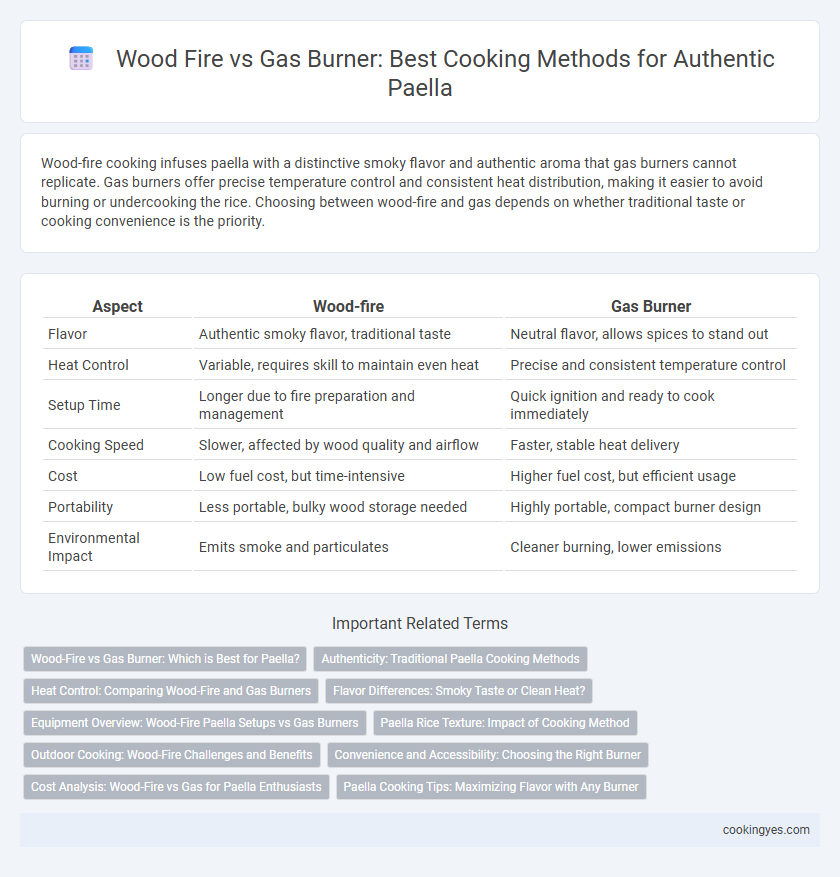Wood-fire cooking infuses paella with a distinctive smoky flavor and authentic aroma that gas burners cannot replicate. Gas burners offer precise temperature control and consistent heat distribution, making it easier to avoid burning or undercooking the rice. Choosing between wood-fire and gas depends on whether traditional taste or cooking convenience is the priority.
Table of Comparison
| Aspect | Wood-fire | Gas Burner |
|---|---|---|
| Flavor | Authentic smoky flavor, traditional taste | Neutral flavor, allows spices to stand out |
| Heat Control | Variable, requires skill to maintain even heat | Precise and consistent temperature control |
| Setup Time | Longer due to fire preparation and management | Quick ignition and ready to cook immediately |
| Cooking Speed | Slower, affected by wood quality and airflow | Faster, stable heat delivery |
| Cost | Low fuel cost, but time-intensive | Higher fuel cost, but efficient usage |
| Portability | Less portable, bulky wood storage needed | Highly portable, compact burner design |
| Environmental Impact | Emits smoke and particulates | Cleaner burning, lower emissions |
Wood-Fire vs Gas Burner: Which is Best for Paella?
Wood-fire imparts a smoky, authentic flavor and uneven heat essential for traditional paella's socarrat, while gas burners provide consistent, controllable heat for precise cooking. Wood-fire requires skill to manage temperature fluctuations and demands outdoor use, whereas gas burners offer convenience, safety, and ease of use, ideal for beginners. Choosing between wood-fire and gas burner depends on prioritizing authentic taste and experience or practicality and control in paella cooking.
Authenticity: Traditional Paella Cooking Methods
Traditional paella cooking relies on wood-fire burners to achieve the distinct smoky aroma and even heat distribution essential for authentic flavor development. Wood-fire imparts subtle char and depth that gas burners cannot replicate, preserving the culinary heritage of Valencia. The use of wood also encourages a natural temperature variation, crucial for forming the signature socarrat crust at the paella's base.
Heat Control: Comparing Wood-Fire and Gas Burners
Wood-fire cooking for paella offers rich, smoky flavors but challenges precision in heat control, making temperature management reliant on experience and wood type. Gas burners provide consistent, adjustable heat levels, allowing precise temperature control vital for even cooking and perfect socarrat formation. Professional chefs often prefer gas burners for reliability, while traditionalists value wood-fire for authentic taste despite fluctuating heat.
Flavor Differences: Smoky Taste or Clean Heat?
Wood-fire cooking imparts a rich, smoky flavor to paella, enhancing the dish with authentic charred notes from burning wood that infuse the rice and ingredients. Gas burners provide clean, consistent heat, allowing precise temperature control but lack the distinctive smoky aroma that characterizes traditional paella. Choosing wood-fire offers a deep, earthy taste that gas burners cannot replicate, while gas burners ensure even cooking without altering the dish's inherent flavors.
Equipment Overview: Wood-Fire Paella Setups vs Gas Burners
Wood-fire paella setups provide authentic smoky flavor and traditional cooking ambiance using hardwood logs or charcoal, often requiring a specialized tripod or metal grill support for the paella pan. Gas burners offer precise temperature control, faster heating, and ease of use with adjustable flame settings, typically supplied as portable propane or natural gas rings designed specifically for paella pans. Choosing between wood-fire and gas burners depends on balancing flavor authenticity with convenience and cooking consistency for perfect paella results.
Paella Rice Texture: Impact of Cooking Method
Wood-fire cooking imparts a unique smoky aroma and uneven heat distribution, enhancing the traditional socarrat layer with a slightly crisp texture favored in authentic paella rice preparation. Gas burners provide consistent and controllable heat, resulting in evenly cooked rice grains with a tender yet firm texture, minimizing the risk of burning or undercooking. The choice between wood-fire and gas burner significantly impacts the final paella rice texture, with wood-fire adding complexity and gas offering precision.
Outdoor Cooking: Wood-Fire Challenges and Benefits
Wood-fire cooking enhances paella flavor by imparting a smoky, authentic taste ideal for outdoor gatherings but requires careful heat management and consistent fuel supply. The open flame produces uneven heat zones, challenging cooks to rotate the pan frequently to avoid burning or undercooking. Despite these challenges, wood-fire offers a traditional experience and unique char that gas burners cannot replicate in outdoor paella preparation.
Convenience and Accessibility: Choosing the Right Burner
Wood-fire burners provide authentic smoky flavors and traditional cooking experiences but require more skill and time to manage heat levels. Gas burners offer precise temperature control and quick ignition, making them ideal for convenience and accessibility, especially for novice cooks. Selecting the right burner depends on balancing flavor authenticity with ease of use and cooking consistency.
Cost Analysis: Wood-Fire vs Gas for Paella Enthusiasts
Wood-fire paella cooking typically incurs higher costs due to the price of quality hardwood and the efficiency required for consistent heat, while gas burners offer more controlled fuel consumption and lower ongoing expenses. Upfront investment in wood-fire setups can be significant, including the purchase of wood and maintenance of fire control tools, compared to relatively affordable and widely available propane or natural gas tanks. For paella enthusiasts prioritizing budget-friendly cooking, gas burners deliver cost-effectiveness with ease of temperature regulation and reduced waste.
Paella Cooking Tips: Maximizing Flavor with Any Burner
Wood-fire cooking for paella infuses a smoky aroma that enhances traditional flavors, creating an authentic culinary experience. Gas burners provide precise temperature control, ensuring even cooking and consistent socarrat formation, the prized crispy rice crust. For maximum flavor, adjust heat levels carefully and use seasoned paella pans suitable for both wood-fire and gas cooking methods.
Wood-fire vs Gas Burner for Paella cooking method Infographic

 cookingyes.com
cookingyes.com